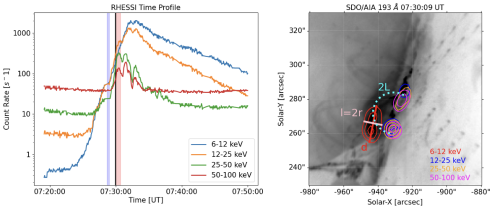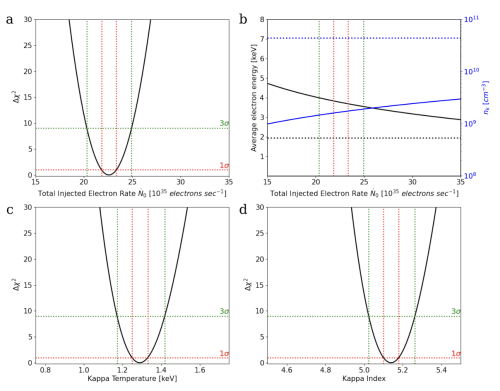The warm-target model and kappa distributions
| Nugget | |
|---|---|
| Number: | 470 |
| 1st Author: | Yingjie LUO |
| 2nd Author: | |
| Published: | September 16, 2024 |
| Next Nugget: | Hard-spectrum Microflares |
| Previous Nugget: | |
Introduction
Observations of hard X-ray (HXR) emissions from solar flares provide crucial insights into the dynamics of solar-flare-accelerated electrons. To accurately determine the energetic electron spectrum from the observed photon spectrum, it is essential to consider the dynamics of accelerated electrons and the shape of the electron distribution. Traditionally, the cold-thick-target model has been used to analyze HXR observations, which assumes that the energy of electrons is significantly higher than the ambient plasma temperature (E >> kT). However, in actual flare conditions, the coronal plasma can reach high temperatures of over 10 MK, challenging the validity of the cold-target assumption. To address this, a physically self-consistent warm-target model has been developed (Ref. [2],[3]), taking into account the complex electron dynamics in the warm-target condition and the electron propagation processes. This model improves on the traditional view by suggesting that accelerated electrons thermalize within the plasma rather than losing their energy and disappearing. Applying the warm-target model to RHESSI observations has shown it to more accurately characterize the nonthermal electron spectrum.
Additionally, at the deka-keV range, it has been suggested that the accelerated energetic electrons may not follow the commonly assumed power-law distribution. The presence of a low-energy cut-off can result in a non-physical discontinuous electron distribution, leading researchers to explore alternative distributions such as the kappa distribution, which might represent the physical consequences of electron acceleration better. The fit of the HXR photon spectrum with a thermal component plus a kappa-form electron spectrum has yielded promising results. Moreover, the kappa distribution covers the entire electron energy range, determining critical physical properties such as total electron number density and electron average energy.
Observations and Results
In the present study (Ref. [1]) we analyzed two M-class solar flares, including an M3.5 flare (SOL2011-02-24) observed by RHESSI (Figure 1). The spectral fit utilized an isothermal component and a warm-target model component. Thermal parameters, essential for the warm-target model, were derived from pre-burst X-ray spectra and imaging data, leaving only the nonthermal electron distribution parameters (total injected electron rate, kappa temperature and kappa index for the kappa distribution) as free parameters in the fit. The best-fit result and obtained electron spectrum are shown in Figure 2. For comparison, the fit results using the warm-target model in power-law distribution are also plotted. The obtained electron spectrum showed significant differences below 30 keV, which corresponds to less nonthermal power generated by the electron spectrum in the kappa distribution.


Furthermore, the Δχ2 curves in Figure 3 indicate that the fit parameters are tightly constrained, with minimal uncertainty, further verified by Monte Carlo analysis. Within the 3-sigma error range, the total electron density derived from the kappa-form electron spectrum was smaller than the ambient plasma density, while the average electron energy was larger than that of the ambient thermal plasma. These findings are consistent with physical constraints.
Conclusion and Summary
The application of the warm-target model with the kappa-form electron distribution in HXR spectral diagnostics of flare-accelerated electrons has demonstrated the ability to accurately determine an electron spectrum. When compared with the electron spectrum obtained for power-law distribution using the same warm-target model, the kappa-form electron spectrum exhibited different behavior below 30 keV and generated notably less total nonthermal power. Furthermore, the critical physical properties derived from the kappa-form electron spectrum, such as total electron number density and average electron energy, were found to satisfy physical constraints. Future research includes aligning the obtained kappa-form electron spectrum with extreme ultraviolet (EUV) data, which is below the X-ray instrument-sensitive range.
